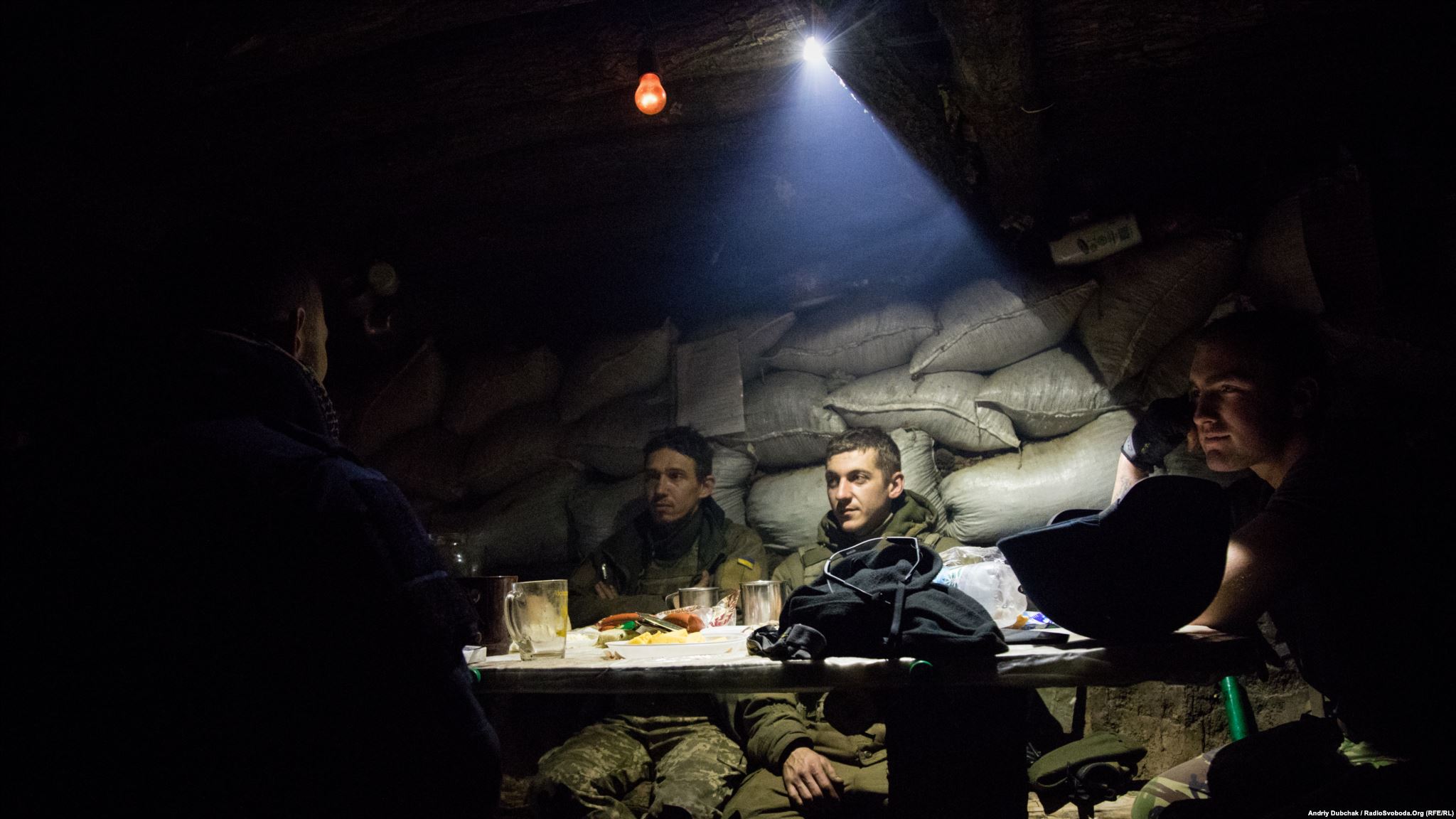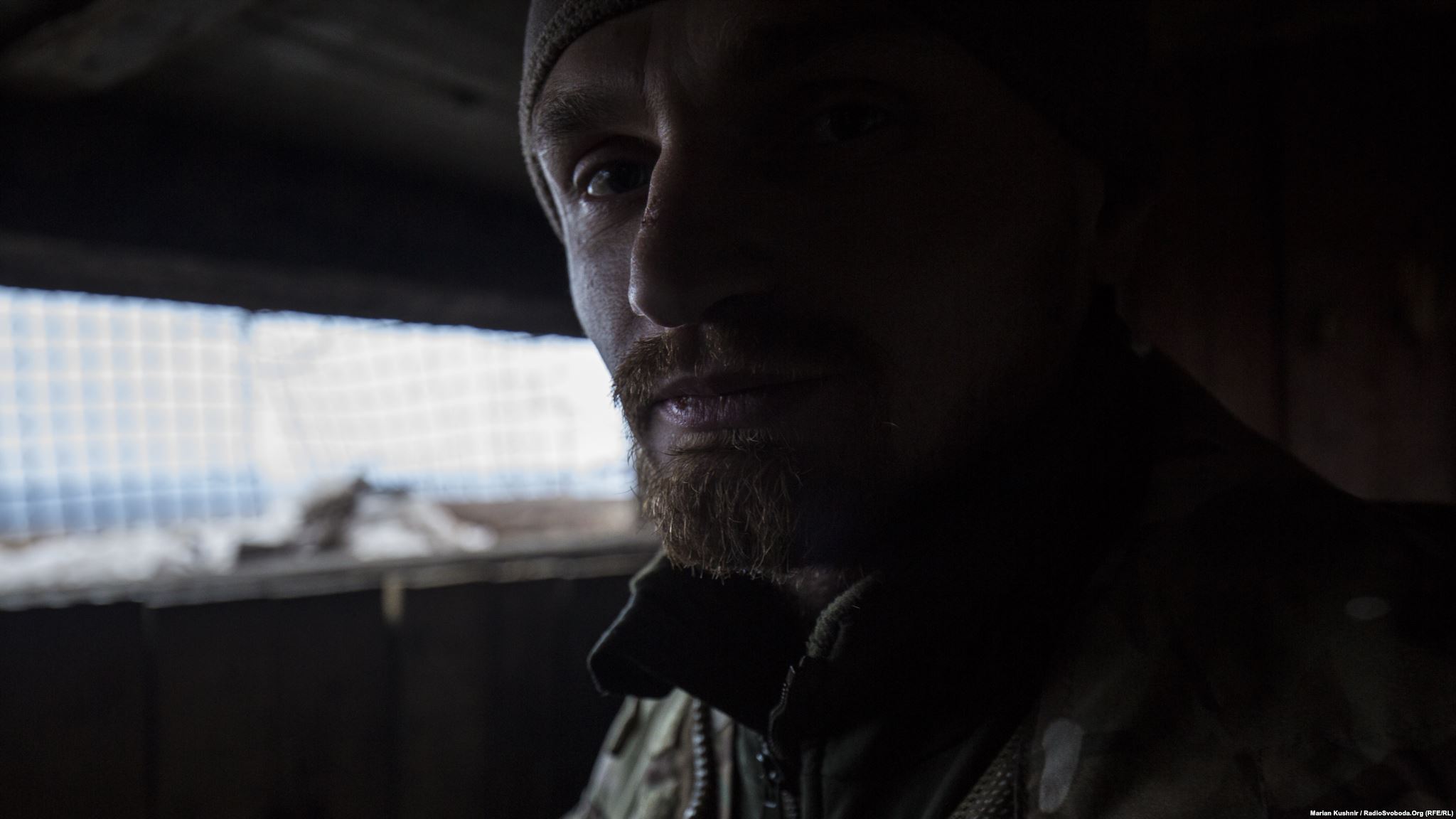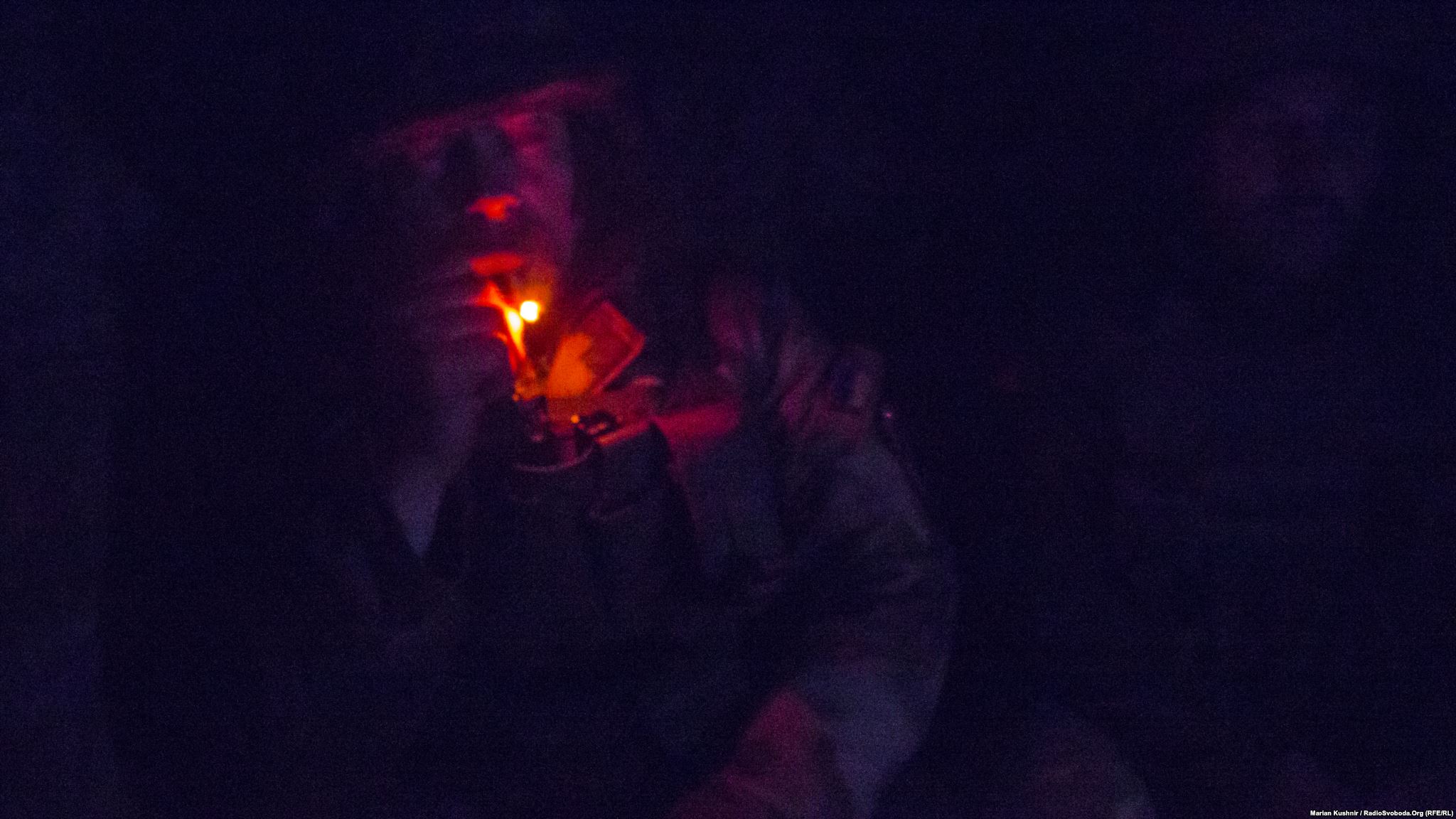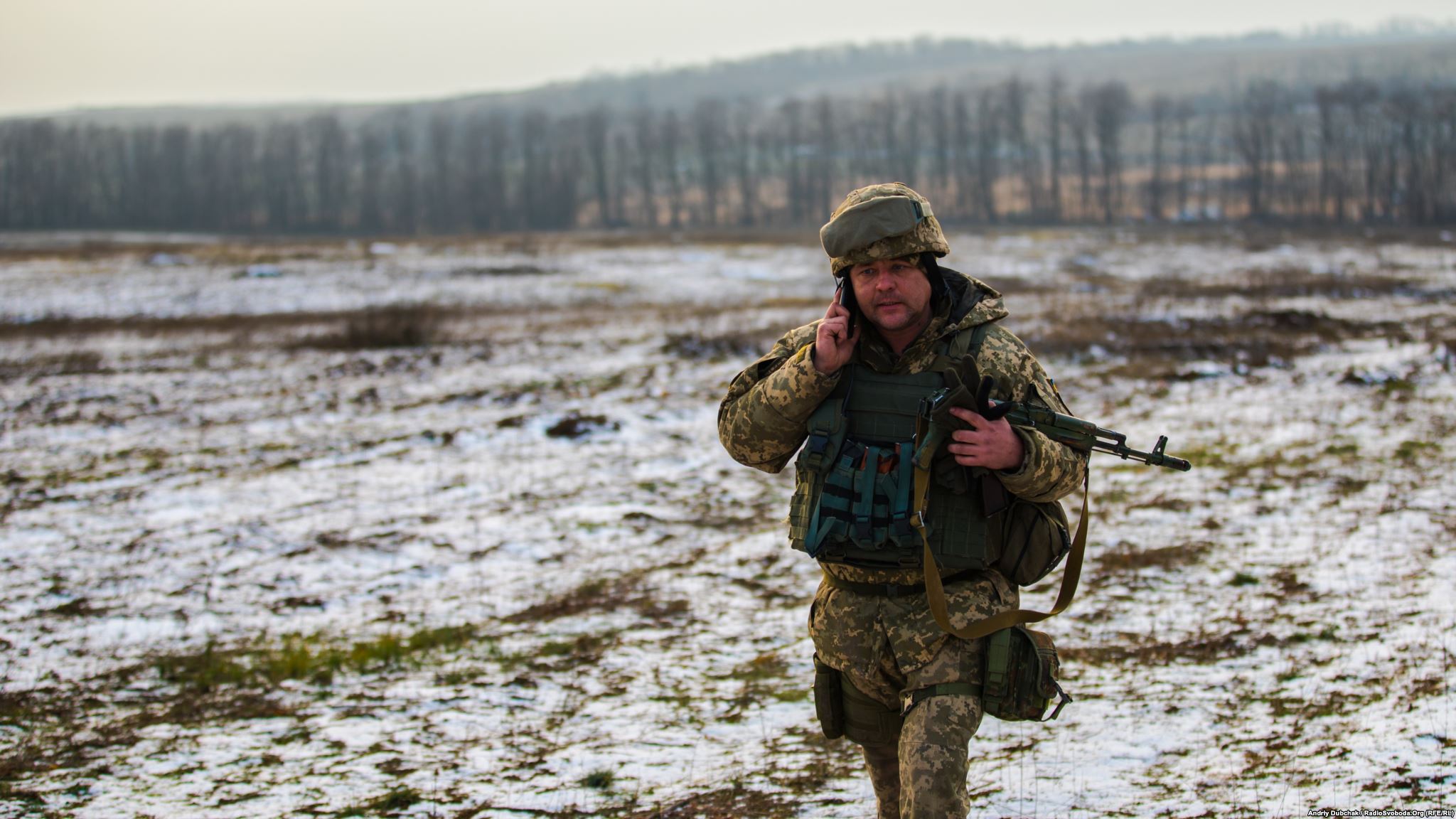The daily combat routine is quite trivial and even boring. Certainly, for an average citizen, a shot from a rifle or RPG is something extraordinary. However, in reality, it does not look as dazzling as an action scene from a movie, and shooting itself is not that frequent.
Donbass trench warfare can be different. Sometimes it is very rapid, like a sniper’s shot. Sometimes it is hot and protracted, like a small-arms firefight between positions that lasts for several hours. What is more, artillery might be involved… Anyway, it is not always possible to film trench warfare because of health and safety reasons.
Three times, we had witnessed combat being initiated and progressed during our brief stay with the separate mountain-assault brigade. Occasionally, rather by chance, we could film some action. Below is our account of the two of them: night action near Popasna and night combat alert mission on positions near Kalynovy.
“Mountain Edelweiss” in night action, near Popasna
In order to get to the frontline position near Popasna, they warm up “beha” for us at the COP (command-observation post). In night time, making our way through mud, we eventually embark good old-fashioned “kopeyka” (infantry fighting vehicle – 1 Ed.).
We didn’t go into “desant” (landing compartment inside the vehicle, protected by armor – Ed.) – the hatches were jammed. Consequently, in the middle of the night, notwithstanding blistering wind, we ride our steel horse amidst fields. In inky darkness, only city lights’ glimmering could be seen somewhere on the horizon, and tree branches that seem to fly right towards us.
In just a few seconds, we disembark the fighting vehicle and move to a dugout. The vehicle proceeded with its combat mission.
Meanwhile, according to the intercepted radio traffic, warriors “calmed” us – they said, “separatists know that someone has arrived.”
A young company commander, Yevhen, meets us; he is only 23 years old. He is our guide today. Firstly, he explains our further itinerary and movements. In impenetrable darkness, we need to go more than a kilometer along a wood lane. We must walk in a chain-like fashion: one after another, with several meters distance between. In case of being shot at, we must crouch or lie down as low as possible; then shooting ends; we must continue our movement in a column.

Thus, we started for immediate small-arms shooting positions. In impenetrable darkness, for a mere distance of several meters, Yevhen fades from view; then he appears and disappears again in the darkness of the wood lane. While our eyes are adjusting to the darkness, and foots are slipping in the mud of a road beaten by military vehicles, we manage to walk through the wood lane. Further, there is a hundred meter breach between wood lanes, says Yevhen, we must run this distance because it is a beaten zone.
There were five of us moving in a column. The first was Yevhen, then two journalists and a soldier who was after his combat duties, and the last was Vjyatsheslav, who accompanied us throughout our entire “journey.” Thus, upon reaching this open ground; Yevhen suggested that he and one of the journalists should run first. Next, after his signal, the rest should follow.
Evidently, after the first run, the enemy, through his thermal scope, detected movement on the open ground. Moreover, during the second run, when the group was already under cover of wood lane, enemy opened fire from machine guns and assault rifles. Bullets whistled overhead.
It is night. We do not know where the enemy is, which side the shooting comes from. It is rather scary. As we jumped in a quite shallow trench, bullets flew overhead with that nasty whistling sound (turn the sound on when watching):
Majority of night engagements resemble this one – almost nothing can be seen and only gun shooting and bullet whistling can be heard.
While on our way to small-arms positions, we had to duck down into the trench mud and hide behind embankments. The intensity of gunfire subsided, that means we may proceed half-bent. The closer it is to the frontline, the deeper the tranches are.
We advance toward small-arms positions. The distance to the Russian-hybrid forces – 800 meters. Ukrainian military shoots back with small-arms.
“Now we suppress enemy fire, who provoked us for an hour,” says “Werewolf,” while watching through a small gun-slot at the fight that develops. He has been in the war since 2014 and entered service in the forefront of patriotism movement and for the love of the country, he says later.
Meanwhile, we witness as a serious night engagement develops. Both parties exchange gunfire; machine guns and assault rifles rattle; tracers fly by; bullets whistle.
At the first look, the engagement is somewhat unreal. Certainly scary, and yet up to this point, it is hard to realize that it is a real combat. Here, soldiers try to kill their enemy. Here, every move can be fatal. Here, anybody around might die.
To a degree possible under the hail of bullets, we move in trenches to film the entire fight. In darkness, we stop at a heavy machine gun position (DSHK 12,7-mm heavy machine-gun of Degtyareva-Shpagina of 1938th standard – Ed.). The machine gun shoots a burst, and a case jams the gun. There is another burst, and, right in the middle of the fight, it gets broken.
This topic deserves some strong language. It is a common problem here – service life of most military equipment nears its end. Warriors complain about their assault rifles, machine guns and AMGL (automatic mounted grenade launcher – Ed). This deficiency is not due to shortage of military equipment – the weapons cannot endure the intensity its usage. Moreover, the situation is not mitigated by the fact that the command of the brigade does everything possible to acquire new equipment and send it to the frontline ASAP. We witnessed the brigade’s medics receiving medical HMV only two days after Americans handed the vehicles over to Ukrainians. Warriors say that the old weapons’ difficulties – perhaps, the number two problem on the list of most critical problems of the army. Number one is undermanning of army units.
They lead us to a reinforced dugout; and, having heard of our visit, a number of warriors come in. For half an hour, we drink tea, warm ourselves and talk on different topics: local situation, problems and motivation.

Single shots, bursts and bigger explosions can be heard from the open ground. An engagement progresses. Half an hour later, grenade launcher men come in. They suggest that we film their “answer” to the enemy pillbox, from which rebels often “work”. They persuade us that it is safe, and that “small-arms rattle” will subside afterwards.
The darkness is palpable. Half-bent, we walk in the tranches to another position. While we walk, they give us earmuffs (antinoise ear plugs –Ed.) to protect our hearing from explosions.
A grenade launcher is always battle ready – in a few seconds, it sends two shots to the enemy’s heavy machine gun, which has been active. The second shot ignites a little sparkle in the distance. Actually, there must be a thousand-degree burning “inferno” caused by shaped charge explosion, which burns the whole thing. It is not clear whether the pillbox was occupied at the moment. It is the nature of war…
We leave our position in a hurry, because they might “answer.” In the trenches, there are “hole-shelters” everywhere that serve as cover during artillery shelling. Moreover, there are many passages, crossings and a lot of other stuff, which we could not see in that darkness. “Look out! Keep your heads down,” they escort and look after us all the time.
On the next position, illuminated by a little flashlight, warriors load magazine cases with bullets. They are shy and scarcely talk. “Wake up the young. That is their concern. Let them talk,” says one of the warriors, who was busy.

Volodymyr, 18-years-old, approaches us. He wears a balaclava and says he does not want to show his face. This very young warrior, armed with an assault rifle, speaks about his motivation.
“I am here not for a price – I defend our country here. But why are they here?(He refers to Russian-hybrid forces. – Ed.) We will kill them till there are no more of them to kill,” says Volodymyr, leaning on his assault rifle. During our conversation, he left the shelter several times “answering” the enemy with his machine gun fire.
Later, we rest for a while in a kitchen. In the warmth and good company, the conversation drifts to the young in the war.
“Look, once this nonsense is over, and he comes back home, but what will he do there? He will want adrenaline that he receives here. There will be only two paths before him: one to the police and the other to a jail,” says Vjyatsheslav. Indeed, what is the way out for these young lads? They have their entire life before them, and how can they rehabilitate themselves? Certainly, this is a serious topic for discussion on the frontline, too.
Fear fading is another serious topic for those in the trenches. They say that soldier who has no fear lacks vigilance, and, therefore, can turn into a battle casualty. These soldiers are often rotated, so that they can regain self-preservation instinct.
Having filmed a lot of interesting material, we decide to stop for the day. Tired and sweating from walking about with considerable weight of equipment and body armours, we walk through fields to the dugout, where we will sleep.
A wood lane is situated to the left from us. With three-meter distance between us, we walk one by one: company commander Yevhen, then two correspondents, and Vjyatsheslav locks the column. We walk past posts of a high-voltage line maimed by shelling. This is the place where a small breach of the wood line is situated.
Suddenly, some distance ahead and little higher than human scale, a blazing tracer bullet flies with a powerful whizz, right near Yevhen, who leads the column. Similar sounds follow – this time made by “regular bullets,” which cannot be seen by eye. In an instant and little late, an assault rifle burst could be heard to the left – ta,ta,ta,ta. It appears that shooting takes place somewhere near. Instantly we duck down right on the mud (training center’s drills were not in vain). It takes some time for us to come to our senses. Then we call one another: “Alive?! Unhurt?!,” “Yes,” “Unhurt?!” “Marjyan”?!, “Yes”!, “Andriy”?!, Alive?! “It seems I’m fine!”
Then Yevhen instructs us: “Go! Quick, Quick! Keep your head down! ” Half-bent, we run through the “ high-voltage” breech in the wood lane, and then more slowly to the dugout. The company commander thinks that we, while running though the wood line’s breech, were detected by enemy’s thermal scope, and that the machine gun burst was fired at random. Probably they tried to frighten us. Their first shot was a “pointing” tracer bullet. “The distance is quite large, about 1000 meters,” says Yevhen. Then he added, “This is how we live here. You either have luck, or you don’t.”
Night combat alert mission in a dugout, on heights near Kalinov
Along the demarcation line, there are battlefield positions of Ukrainian army and Russian-hybrid forces. It is so happened that the demarcation line lies across different terrain: Donbas steppe, infrastructure, industry, housing – thus dividing villages, towns and even some facilities.

Near strong points, or small-arms positions, to be precise, the “most interesting” events happen. Here Russian-hybrid forces most often fire at Ukrainian soldiers; here is the shortest distance to the enemy; and here is the place where real war happens.

In the area of responsibility of the entire brigade, we tried to visit the most interesting locations from a journalist’s perspective.
For example, we stayed overnight at a strong point named “Observer,” which is located on a high ground, and from which a large swathe of occupied territory can be observed. We saw rebels firing.
Mykhajlo recently changed a battalion’s H.Q. for the frontlines. It is his first day at that “Observer” position, in the company of a veteran nicknamed “Didick.” “Didick” shares experience, so that Mykhajlo should know how to perform in different situations.

Night turns out to be quiet. We have time to converse. Repeatedly, in total darkness, either Mykhajlo or “Didick” stands up and look out through a gun-slot. A night vision scope helps to monitor the situation.
“We regularly experience “nightmares”: 12,7 millimeters, sometimes 14,5 and 7,62 all the time. There were cases, when 5,45 mm bullets flayed in through the gun-slot,” says Didick, fidgeting with a night vision scope.
Soldiers are on duty for several hours, and we have plenty of time to speak about war, combat, and outside world’s perception.
“Don’t talk about politics. Though, we have something to say, but we can’t – since we are soldiers. Our duty – to carry out orders and defend our country,” says Mykhajlo, when conversation drifts to events unfolding in the capital for the last several months. “
“When I come home, the question that strikes me most – “When will the war end?” How do I know? We do everything that depends from us. However, there is one thing that I will never get used to – when you have to inform relatives that their son, or husband, or other family member is no more. When that mobile rings and you have to answer, and you can hear a female voice saying, “Hello! Hello! Sashku, Sashku, how you? Hello! Why are you silent?” Moreover, you stand there, not knowing with what to begin. You talk some nonsense, trying to express your apologies and sympathies. In such moments, my voice trembled, with hands and feet wobbly. There would be silence on the other end. Then you would hear weeping and hysterics. That was the hardest thing,” recalls Mykhajlo.
Sometime later, there is a flare in total darkness. Sound follows in a few seconds. It is an “exit.” Guys monitor the situation.
This is an enemy fighting vehicle or SPG (throughout night, it is not easy to figure out what it was) fire at positions of their “neighbors.” There are some shots and machine gun bursts, and everything becomes silent, until morning.
Owing to these few days that we spent with the guys on combat duties, we gained an insight of what really happens at the front, and that it is real, not theatrical. Vjyatsheslav Skoryak, who escorted us throughout our journey, often told soldiers, “Look, journalists from Radio Liberty arrived to film you. They film not these pencil pushers like me, but you, who fight at the front.” There are some shades of irony in his tone. However, it is worth noting that (we witnessed it ourselves), despite his self-deprecating humor, the major does lots of work. Like the proverbial hamster in the spinning wheel, he does a job of civil-military cooperation representative from the brigade. Today he tackles issues with civilians, tomorrow with the military. One day he fetched a civilian killed by a grenade in a wood line near Zolotogo. Sometimes he coordinated actions with representatives of СММ OSCE and JCCC. Moreover, all of it was done at the front. Additionally, he works on a whole lot of documentation.

“It is my job, and I really enjoy it,” acknowledged Vjyatsheslav, at the end of our journey.
(Supplementary information)
Approximate sketch of military deployment along the front lines.
Usually it looks like this: there is battalion’s COP (command-observation post), which coordinates all unites in its area of responsibility. Down through the hierarchy is CDA (company defense area), where engagement control and company’s combat command takes place. Next comes PS (platoon strongpoint), which is located directly on the contact line. Fire and observation posts are connected to it. This is how defenses are organized along the demarcation line. According to military science, PSs and CDAs should be located close to each other and, and in line with the manning chart, should cover limited defense line. However, taking into account personnel shortage that the military already makes no secret of, PSs and CDAs are placed in great distances from each other (Wikipedia about ZSU composition). Soldiers have to walk these distances, as they say, “using 11th traffic route” – that is on foot.

Afterword
Within a few days, Radio Liberty correspondents visited many of the frontline positions under Popasna, which were under the control of a separate mountain-assault brigade. Given the considerable number and versatility of the footage, it was decided to present the story of the brigade in three separate but related publications:
